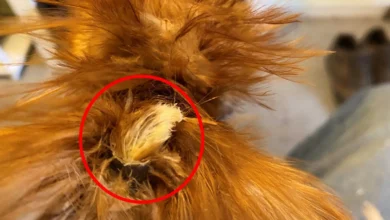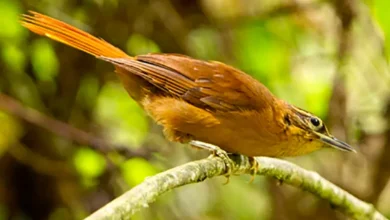The Spot-billed Toucanet (Selenidera maculirostris) are South American toucans that form a superspecies with Tawny-tufted Toucanets (of northern South America), Golden-collared Toucanet (of the western part of the Amazon Basin) and Gould’s Toucanet (of central Amazonian Brazil). They were formerly considered conspecific (one species) with the Gould’s Toucanet.

Distribution / Range
The Spot-billed Toucanets are found in the Atlantic Forest of south-eastern Brazil – specifically in southern Bahia and eastern Minas Gerais south to Paraná and Santa Catarina; and possibly Rio Grande do Sul). They are also native to adjacent eastern Paraguay and the northeastern Argentinian province of Misiones. They inhabit forests and palm groves.
They are usually seen in pairs, hopping around in dense vegetation as they search for food.
Alternate (Global) Names
Chinese: ?????? … Czech: Arassari skvrnozobý … Danish: Pletnæbbet Tukanet … Dutch: Vleksnavelpepervreter, Vleksnavel-pepervreter … Finnish: Täplänokkatukaani … French: Araçari à bec tacheté, Toucanet à bec tacheté … German: Fleckenarassari, Flecken-Arassari, Goldohrarassari … Guarani: Tuk pôka … Irish: Túcáinín gob-bhallach … Italian: Tucanetto beccomacchiato, Tucanetto beccomaculato … Japanese: fuirikochuuhashi … Norwegian: Flekknebbtukan … Polish: tukanik plamodzioby … Portuguese: araçari-boi, araçari-poca, araçari-poca-de-bico-pintalgado, araçari-tirador-de-leite, cagão, sari-poca, Saripoca-de-bico-riscado … Russian: ???????????? … Slovak: tukaník škvrnitozobý … Spanish: Arasarí chico, Tucán pico manchado, Tucancito de Pico Maculado, Tucanete Piquimaculado … Swedish: Fläcknäbbad tukanett
Description
The male’s plumage below is black and the back and tail are olive-green. The head is also black, except for the green-blue bare skin around the eyes and yellow ear-tufts. The female looks similar, but can be identified by her chestnut-colored head and her rufous-colored under plumage.
The bill is ivory colored with black vertical stripes and large spots, and a yellowish tip. The eyes are mostly yellow, except for dark spots just before and behind the pupil, giving it the effect of having a slit-shaped pupil.
Spot-billed Toucanets measure about 14 inches (34 cm) in length, including the tail. They weigh between 4.9 – 7.1 oz (140 – 200 g).

Similar Species
The Spot-billed Toucanet resembles the Gould’s Toucanet – except for the bill pattern.
Calls / Vocalizations
Their vocalizations are describes as distinctly frog-like calls.
Breeding / Nesting
The mating ritual is a fun-loving affair for toucans, as they throw fruit to one another.
Like all of their other activities, nesting happens high up in hollow areas in trees. The bill is not effective for digging or any other type of extensive excavation work and so they must rely on holes already formed by other means.
The nests are not lined, but the two to four shiny white eggs that are laid each year rest on a few wood chips created while enlarging the opening or on various kinds of regurgitated seeds collected for this purpose. Parents share equally in incubation duties, but rarely sit on the nest for more than an hour at a time and the eggs are often left uncovered. Both parents share in feeding fruit to the babies for up to 8 weeks.
After 16 days the nestlings are born blind, with no trace of down on their pink skin. The bill is unremarkable until about 16 days old when it takes on the distinguishing features of the toucan, and requires up to four months to develop fully.Feathers begin to expand at 4 weeks.
Babies have pads on their elbows that protect their feet by keeping them elevated until they fledge.
Breeding in captivity requires attention to a number of details. Even successful breeders report rates as low as 30% for the incubation of eggs.
Toucan Trivia: Unexpected, Interesting and Fun Facts about the Toucan Family of Birds



